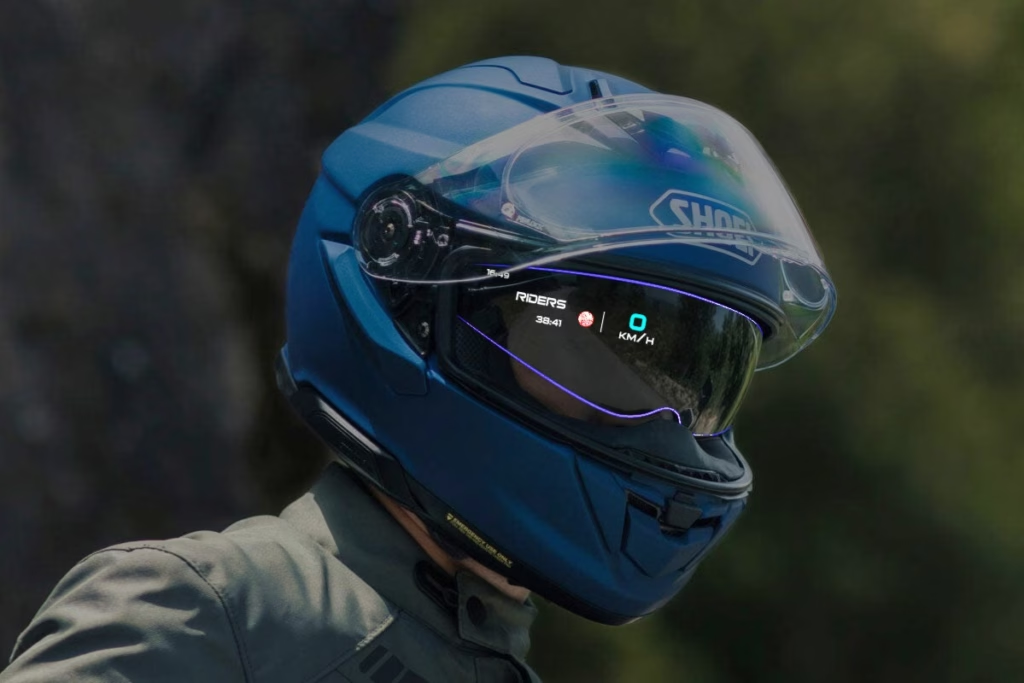
Helmet technology has been moving at full throttle lately. We have seen some truly wild innovations, from helmets that promise complete blind spot elimination to those that purify the air you breathe. Brands like Sena and Cardo have already stepped into the world of smart helmets, adding all kinds of tech to traditional lids. But now Shoei has taken things a huge step forward.
Say hello to the GT Air 3 Smart, the world’s first helmet with fully integrated augmented reality. To bring this to life, Shoei teamed up with EyeLights, a French company known for its cutting edge HUD head up display systems and audio tech. If the name rings a bell, they are the same folks behind the futuristic Rocket One concept helmet revealed at EICMA.
Augmented Reality Right in Your Line of Sight
EyeLights fitted this full face helmet with a visor level HUD that projects essential riding information directly into your line of vision. No more glancing down at your dash or fumbling with a handlebar mounted phone. Everything you need is right there such as speed, GPS directions, incoming calls, and radar alerts.
The projection appears as if it is three meters in front of you, which helps with focus and safety. EyeLights claims this reduces reaction time by more than 32 percent. That is a big deal when you are navigating city traffic or cruising highways at speed.
One common problem with HUD systems is visibility in bright sunlight. This is where the GT Air 3 Smart stands out. The helmet uses a nano OLED Full HD display designed to remain readable even when the sun is shining at its brightest. The idea is simple. You keep your eyes forward and only glance slightly upward for information without distraction.
Communication Tech Built Right In
Shoei did not stop at AR. The GT Air 3 Smart includes a universal intercom system with what EyeLights calls unlimited range. It is compatible with every major brand and it operates in both online and offline mesh modes. The helmet is equipped with a microphone featuring active noise cancellation and it supports voice assistants like Siri and Google Assistant.
Battery life is expected to exceed 10 hours of use and the entire system consisting of speakers, wires, battery, projector, and microphone is fully integrated inside the helmet shell. There is no bolt on hardware or awkward external modules hanging off the side.
Built With Shoei’s Trusted Safety and Comfort
Of course, all that technology would not mean much if the helmet itself were not safe. Shoei maintains its strong safety reputation here. The GT Air 3 Smart meets both DOT and ECE 22.06 standards thanks to Shoei’s AIM Advanced Integrated Matrix multi layer composite shell.
A standard GT Air 3 weighs around 3.9 pounds or 1.77 kilograms. The Smart version will weigh a little more although Shoei has not revealed the exact number yet. You still get premium features including the QSV 2 drop down sun visor, a Pinlock ready CNS 1C shield, and Shoei’s advanced ventilation system with adjustable intake vents and exhaust ports for airflow and fog prevention.
Style, Sizes, and Pricing
The GT Air 3 Smart comes in five sleek colors including White, Matte Black, Matte Metallic Blue, Matte Metallic Gray, and REALM TC10. Sizes range from S to XXL. Pricing is set at 1,199 US dollars which is nearly double the cost of the standard GT Air 3.
Worth the Price
There is no doubt this helmet brings something groundbreaking to the table. Still, it is not the only player in the smart helmet space. The Sena Phantom comes in at a far more affordable 499 dollars while Cardo’s Beyond GTS matches Shoei at 1,199 dollars. Neither of these offers integrated AR HUD visual technology, and they are mainly aimed at riders who want built in intercom functionality.
So, the big question is whether the price is justified. When you create the world’s first fully integrated AR motorcycle helmet, perhaps you do earn the right to ask a premium price. Whether riders agree is another story.
What do you think Would you spend 1,199 dollars for AR riding tech and full integration or stick with something more traditional and budget friendly.
Source: EyeLights

